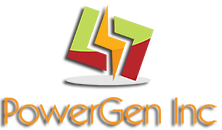ANNUAL SERVICES
Before Starting Engine:
- Check engine oil level and coolant level.
- Check block heater to maintain coolant temp. (Approximately 110 Deg. F in the block)
- Check fuel level in storage tank advise when main fuel tank is below % full.
- Check fuel day tank pump manually for proper operation if applicable.
- Check battery water level and top as necessary.
- Check battery voltage. (13 – 14 VDC or 26 – 27 VDC)
- Check battery terminals for corrosion and connections for tightness (clean if necessary)
- Check visually engine/generator electrical wiring harnesses and terminal connections
- Check engine/generator control panel gauges and alarm lights
- Check equipment mounting (vibration isolators) and accessory mounts
- Check radiator for plugging, level switch if applicable, and leaks.
- Check engine governor controls (linkage) if applicable
- Check air induction system including turbocharger
Engine Running:
- Check oil pressure, fuel pressure, belt driven accessory drives.
- Check oil level and add oil as required.
- Check generator frequency (including stability), voltage, temperatures and pressures
- Check for leaks or unusual noises.
- Check engine exhaust system
- Check engine cooling fan
After Stopping Engine:
- Check fuel level in tank.
- Record battery charger volts, check for proper operation.
- Remove, clean and reinstall all battery connections if necessary.
- Inspect generator for cleanliness.
- Drain crankcase oil and replace with new oil. Take oil samples for analysis.
- Remove and replace oil and fuel filters
- Inspect air filter(s)
- Perform Load Bank testing
* Start engine and operate using resistive load bank for a period of Four (4) hours.
* Check generator output-voltage, frequency, amperage, temperatures and pressures every 15 minutes (record onto chart)
Reporting:
- Provide service report for each visit and advise customer of potential problems which will require further attention.
INSPECTION SERVICE—Monthly, Quarterly or Semi-Annual
General Inspection:
• Visually check complete engine/generator set
• Check equipment mounting (vibration isolators) and accessory mounts.
Engine Controls and Control Panel:
• Check engine/generator control panel gages and alarm lights.
• Check instruments for normal operation
• Verify controls are set in automatic mode if applicable.
Engine Lubrication System:
• Check oil level and add oil as required.
• Check oil pressure using equipment mounted gauge
Engine Cooling System:
• Check engine coolant level, concentration of coolant conditioner (inhibitor)
• Check engine cooling fan and radiator condition
• Check condition of belts, hoses, and plumbing connections
• Check jacket water heater temperature
Engine Fuel System:
• Check fuel levels in day tank and main tank
• Check fuel pressure using equipment mounted gauge
• Check fuel piping for leaks
Engine Air Induction System:
• Check air intake system piping, air cleaner and air restriction gauge
• Check engine exhaust system including after treatment devices
Engine Governor:
• Check linkage and ball joints (if applicable)
• Check air/fuel ratio control (if applicable)
• Check for leaks, oil level (if applicable) Engine Electrical Starting System:
• Check visually batteries and connections, water level and correct if necessary
• Check battery cap vents (if applicable)
• Check battery charging system for proper operation
Generator and Generator Switchgear:
Check generator frequency, voltage, amperage using building load (if applicable)
Check air screen, leaks or unusual noises.
Inspect generator for cleanliness.
Operate generator circuit breaker (if applicable)
WEEKLY INSPECTIONS
General Inspection:
Visually check complete engine/generator set
Engine Controls and Control Panel:
• Check engine/generator control panel gages and alarm lights
• Verify controls are set in automatic mode if applicable
Engine Lubrication System:
• Check oil level and add oil as required
Engine Cooling System:
• Check engine coolant level and coolant as required
• Check engine cooling fan and radiator condition
• Check condition of belts, hoses, and plumbing connections
• Check jacket water heater temperature
Engine Fuel System:
• Check fuel levels in day tank and main tank
Check fuel piping for leaks
Engine Air Induction System:
• Check air intake system piping, air cleaner and air restriction gauge
• Check engine exhaust system including after treatment devices
Engine Governor:
• Check linkage and ball joints (if applicable)
• Check air/fuel ratio control (if applicable)
• Check for leaks, oil level (if applicable)
Engine Electrical Starting System:
• Check visually batteries and connections
• Check battery cap vents (if applicable)
• Check battery charging system for proper operation Generator:
• Inspect generator for cleanliness
Reporting:
• Fill in log book at each Generator.
Emergency Servicing:
• 2-hour emergency response time.
• Provide 24-hour emergency repair coverage.
TRANSFER SWITCH INSPECTION AND SERVICE
General Inspection:
• Visually check Transfer Switch.
• Visually check all electrical connections (Thermo scan).
Service:
Tag out / Lock out Transfer Switch and Generator(s)
Remove AC Power to Transfer Switch (Customer to Bypass or Open Breaker to switch)
Thoroughly dust and vacuum all controls, meters, switching mechanism components, interior
buswork, and lug connections.
Inspect buswork and supporting hardware for carbon tracking, cracks, corrosion or any other types deterioration.
Check stationary and movable contacts.
Lubricate all moving parts and check for binding.
Check all hardware for loose connections.
Check all wiring and load cables for Signs of wear or deterioration.
Restore store Transfer Switch and Generator(s) to auto standby mode.
Testing:
• Standby while customer test system (Auto Transfer)
• Record all time delays during transfer and retransfer.
• Re-thermo scan all connections.
• Check for any voltage drops across contacts during test
• On completion of test, provide written report.
